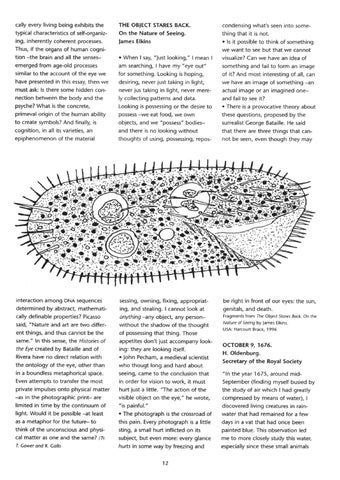cally every living being exhibits the typical characteristics of self-organizing, inherently coherent processes. Thus, if the organs of human cognition -the brain and all the sensesemerged from age-old processes similar to the account of the eye we have presented in this essay, then we must ask: Is there some hidden connection between the body and the psyche? What is the concrete, primeval origin of the human ability to create symbols? And finally, is cognition, in all its varieties, an epiphenomenon of the material
interaction among ONA sequences determined by abstract, mathematically definable prope~ies? Picasso said, "Nature and art are two different things, and thus cannot be the same." In this sen se, the Histories of the Eye created by Bataille and of Rivera have no direct relation with the ontology of the eye, other than in a boundless metaphorical space. Even attempts to transfer the most private impulses onto physical matter -as in the photographic print- are limited in time by the continuum of light. Would it be possible -at least as a metaphor for the future- to think of the unconscious and physical matter as one and the same? ITr. T. Gower ond R. Gaflo
THE OBJECT STARES BACK. On the Nature of Seeing. James Elkins o When I say, "Just looking," I mean I am searching, I have my "eye out" for something. Looking is hoping, desiring, never just taking in light, never jus taking in light, never mereIy collecting patterns and data. Looking is possessing or the desire to possess -we eat food, we own objects, and we "possess" bodiesand there is no looking without thoughts of using, possessing, repos-
sessing, owning, fixing, appropriating, and stealing. I cannot look at anything -any object, any personwithout the shadow of the thought of possessing that thing. Those appetites don't just accompany looking: they are looking itself. o John Pecham, a medieval scientist who thougt long and hard about seeing, came to the conclusion that in order for vis ion to work, it must hurt just a little. "The action of the visible object on the eye," he wrote, "is painful. " o The photograph is the crossroad of this pain. Every photograph is a little sting, a small hurt inflicted on its subject, but even more: every glance hurts in some way by freezing and 12
condensing what's seen into something that it is noto o Is it possible to think of something we want to see but that we cannot visualize? Can we have an idea of something and fail to form an image of it? And most interesting of all, can we have an image of something - an actual image or an imagined oneand fail to see it? o There is a provocative theory about these questions, proposed by the surrealist George Bataille. He said that there are three things that cannot be seen, even though they may
be right in front of our eyes: the sun, genitals, and death. F,agments f,om The Objed S/ares 8ock. On /he Na/ure al Seeing by James Elkins.
USA: Ha,caurt Brace, 1996
OCTOBER 9, 1676. H. Oldenburg. Secretary of the Royal Society "In the year 1675, around midSeptember (finding myself busied by the study of air which I had greatly compressed by means of water), I discovered living creatures in rainwater that had remained for a few days in a vat that had once been painted blue. This observation led me to more closely study this water, especially since these small animals
